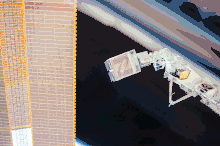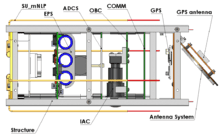UPSat
 UPSat minutes after deployment from the ISS | |
| Mission type | Thermosphere research, part of the QB50 mission |
|---|---|
| Operator | University of Patras, Libre Space Foundation |
| COSPAR ID | 1998-067LX |
| SATCAT no. |
42716 |
| Website | http://upsat.gr |
| Mission duration | TBA |
| Spacecraft properties | |
| Manufacturer | University of Patras, Libre Space Foundation |
| Launch mass | 2kgr |
| Start of mission | |
| Launch date | 2017/04/18 |
| Rocket | Atlas-V |
| Launch site | Cape Canaveral |
| End of mission | |
| Decay date | Launch + <6 months |
| Orbital parameters | |
| Reference system | Geocentric |
| Regime | Low Earth |
| Semi-major axis | TBA |
| Eccentricity | TBA |
| PeriTBA | TBA |
| ApoTBA | TBA |
| Inclination | TBA |
| Period | TBA |
UPSat is the first satellite manufactured in Greece,[1] by the University of Patras and Libre Space Foundation. It is part of the QB50 mission with ID GR-02. The UPSat mission aspires to be the first satellite launched into orbit made entirely of open-source software and open-source hardware.[2]
Open-source
The UPSat mission aims to develop an open-source hardware and software 2U cubesat, minimizing the use of commercial off the shelf components, and providing hardware and software designs under the provisions of the CERN-OHLv2 [3] and GNU-GPLv3[4] licenses respectfully. The vast majority of its components are designed from scratch in an open-source software and hardware way.
Mission

UPSat, as part of the QB50 cubesat constellation, was launched to the International Space Station at April 18, 2017 11:11 EDT at Cape Canaveral in Florida, on board an Atlas V rocket transferring the Cygnus cargo spacecraft to dock with the International Space Station with supplies and other scientific experiments. UPSat was released in orbit by the NanoRacks deployer from the International Space Station at 08:24 UTC 2017-05-18. After 30 minutes, UPSat subsystems commenced normal operations in orbit. The SatNOGS ground-station network started receiving telemetry signals from UPSat in several ground-stations deployed globally shortly after its deployment.[5] all data and telemetry is publicly available.
Subsystems
General

EPS (Electrical Power System) An EPS designed from scratch around an STM32L1 MCU, utilizing software MPPT, harnessing power from 7 solar panels and having a 3-cell battery system.
OBC (On board Computer) An OBC designed from scratch around an STM32F4 MCU, with software built around FreeRTOS Operating System
ADCS (Attitude Determination and Control System) An ADCS designed from scratch around STM32F4 MCU, determining attitude and position through sensor fusion (GPS, magnetometer, gyro, sun sensor). The sensor fusion algorithm used is based on an alternative implementation of Wahba’s problem, in order to accommodate gyro measurements, as introduced in.[6] This implementation uses a virtual vector base, propagated by the gyro reading, fused with the vectors provided by the sun sensor and the magnetometer, as per Wahba’s problem. This forms essentially a complementary filter in SO(3) between the gyro and the vector measurements. The reference vectors in ECI frame are calculated by[7] and IGRF model, respectively, given the satellites position is known by the GPS and SGP4 model. The control system is based on a spin torquer, which is used as a reaction wheel for pitch control and also to stiffen roll and yaw to the satellite's orbit plane (Gyroscopic torque and momentum bias). Magneto-torquers are also used to dampen the roll and yaw motion while also control pitch angle.
SU (Science Unit) (see primary payload)
COMM (Communications system) A COMM designed from scratch around an STM32F4 MCU, using the TI CC1120 transceivers, with contingency around TX operations combined with a custom Antenna deployment system with integrated GPS antenna.
IAC (Image Acquisition Component) (see secondary payload)
Structure The structural sub-system is based on a “hybrid” approach of both Aluminum (frame) and CFRP components (4 faces), built in-house.
Primary payload
On-board UPSat, the primary payload, a science unit is integrated. The science unit (designed by the University of Oslo and supplied through the Von Karman Institute as part of the QB50 program) will be used for plasma measurements during the mission duration. The science unit is a multi-Needle Langmuir Probe instrument works by measuring the current collected individually from four needle probes, placed in front of the satellite’s shock front. The collected current is converted to voltage, filtered, digitalized and then sent to the central telemetry system. [9]
Secondary payload
As a secondary payload UPSat sports an embedded Linux board (DART-4460) running a modified version of the OpenWRT operating system controlling a b/w camera (MU9PM-MH) with 1 / 2.5’’ sensor size. [10]
References
- ↑ ""UPSat": O πρώτος δορυφόρος ελληνικής κατασκευής!". euronewsgr.
- ↑ "UPSat (QB50 GR02)". space.skyrocket.de.
- ↑ "UPSat COMMS hardware license". Github. Retrieved 12 July 2017.
- ↑ UPSat OBC software license https://github.com/librespacefoundation/upsat-obc-software/blob/master/LICENSE. Retrieved 12 July 2017. Missing or empty
|title=(help) - ↑ "UPSat, an open-source Greek satellite". Space Daily. Retrieved 18 May 2016.
- ↑ Marantos, Panos; Koveos, Yannis; Kyriakopoulos, Kostas J. (July 2016). "UAV State Estimation Using Adaptive Complementary Filters". IEEE Transactions on Control Systems Technology. 24 (4): 1214–1226. doi:10.1109/TCST.2015.2480012.
- ↑ McClain, David A. Vallado ; with technical contributions by Wayne D. (2007). Fundamentals of astrodynamics and applications (3rd ed.). New York: Springer. p. 281. ISBN 978-0-387-71831-6.
- ↑ "Subsystems – UPSat". upsat.gr.
- ↑ "UPSat Scientific Unit". UPSat. 25 March 2016. Retrieved 12 July 2017.
- ↑ "UPSat Image Acquisition Component". UPSat. 25 March 2016. Retrieved 12 July 2017.